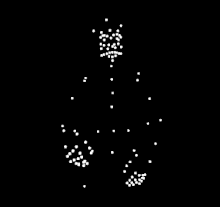
Biological motion is motion that comes from actions of a biological organism. Humans and animals are able to understand those actions through experience, identification, and higher level neural processing.[1] Humans use biological motion to identify and understand familiar actions, which is involved in the neural processes for empathy, communication, and understanding other's intentions. The neural network for biological motion is highly sensitive to the observer's prior experience with the action's biological motions, allowing for embodied learning. This is related to a research field that is broadly known as embodied cognitive science, along with research on mirror neurons.
For instance, a well known example of sensitiveness to a specific type of biological motion is expert dancers observing others dancing. Compared to people who do not know how to dance, expert dancers show more sensitiveness to the biological motion from the dance style of their expertise. The same expert dancer would also show similar but less sensitivity to dance styles outside of their expertise. The differences in perception of dance motions suggests that the ability to perceive and understand biological motion is strongly influenced by the observer's experience with the action. A similar expertise effect has been observed in different types of action, such as music making, language, scientific thinking, basketball, and walking.